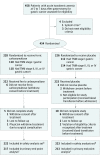Effect of Intravenous Ferric Carboxymaltose on Hemoglobin Response Among Patients With Acute Isovolemic Anemia Following Gastrectomy: The FAIRY Randomized Clinical Trial
- PMID: 28535237
- PMCID: PMC5815040
- DOI: 10.1001/jama.2017.5703
Effect of Intravenous Ferric Carboxymaltose on Hemoglobin Response Among Patients With Acute Isovolemic Anemia Following Gastrectomy: The FAIRY Randomized Clinical Trial
Abstract
Importance: Acute isovolemic anemia occurs when blood loss is replaced with fluid. It is often observed after surgery and negatively influences short-term and long-term outcomes.
Objective: To evaluate the efficacy and safety of ferric carboxymaltose to treat acute isovolemic anemia following gastrectomy.
Design, setting, and participants: The FAIRY trial was a patient-blinded, randomized, phase 3, placebo-controlled, 12-week study conducted between February 4, 2013, and December 15, 2015, in 7 centers across the Republic of Korea. Patients with a serum hemoglobin level of 7 g/dL to less than 10 g/dL at 5 to 7 days following radical gastrectomy were included.
Interventions: Patients were randomized to receive a 1-time or 2-time injection of 500 mg or 1000 mg of ferric carboxymaltose according to body weight (ferric carboxymaltose group, 228 patients) or normal saline (placebo group, 226 patients).
Main outcomes and measures: The primary end point was the number of hemoglobin responders, defined as a hemoglobin increase of 2 g/dL or more from baseline, a hemoglobin level of 11 g/dL or more, or both at week 12. Secondary end points included changes in hemoglobin, ferritin, and transferrin saturation levels over time, percentage of patients requiring alternative anemia management (oral iron, transfusion, or both), and quality of life at weeks 3 and 12.
Results: Among 454 patients who were randomized (mean age, 61.1 years; women, 54.8%; mean baseline hemoglobin level, 9.1 g/dL), 96.3% completed the trial. At week 12, the number of hemoglobin responders was significantly greater for ferric carboxymaltose vs placebo (92.2% [200 patients] for the ferric carboxymaltose group vs 54.0% [115 patients] for the placebo group; absolute difference, 38.2% [95% CI, 33.6%-42.8%]; P = .001). Compared with the placebo group, patients in the ferric carboxymaltose group experienced significantly greater improvements in serum ferritin level (week 12: 233.3 ng/mL for the ferric carboxymaltose group vs 53.4 ng/mL for the placebo group; absolute difference, 179.9 ng/mL [95% CI, 150.2-209.5]; P = .001) and transferrin saturation level (week 12: 35.0% for the ferric carboxymaltose group vs 19.3% for the placebo group; absolute difference, 15.7% [95% CI, 13.1%-18.3%]; P = .001); but there were no significant differences in quality of life. Patients in the ferric carboxymaltose group required less alternative anemia management than patients in the placebo group (1.4% for the ferric carboxymaltose group vs 6.9% for the placebo group; absolute difference, 5.5% [95% CI, 3.3%-7.6%]; P = .006). The total rate of adverse events was higher in the ferric carboxymaltose group (15 patients [6.8%], including injection site reactions [5 patients] and urticaria [5 patients]) than the placebo group (1 patient [0.4%]), but no severe adverse events were reported in either group.
Conclusion and relevance: Among adults with isovolemic anemia following radical gastrectomy, the use of ferric carboxymaltose compared with placebo was more likely to result in improved hemoglobin response at 12 weeks.
Trial registration: clinicaltrials.gov Identifier: NCT01725789.
Conflict of interest statement
Figures


Comment in
-
Ferric Carboxymaltose to Treat Isovolemic Anemia.JAMA. 2017 Oct 3;318(13):1281. doi: 10.1001/jama.2017.11637. JAMA. 2017. PMID: 28973241 No abstract available.
References
-
- Gombotz H, Rehak PH, Shander A, Hofmann A. Blood use in elective surgery: the Austrian benchmark study. Transfusion. 2007;47(8):1468-1480. - PubMed
-
- Shander A, Knight K, Thurer R, Adamson J, Spence R. Prevalence and outcomes of anemia in surgery: a systematic review of the literature. Am J Med. 2004;116(suppl 7A):58S-69S. - PubMed
-
- Weiskopf RB, Kramer JH, Viele M, et al. . Acute severe isovolemic anemia impairs cognitive function and memory in humans. Anesthesiology. 2000;92(6):1646-1652. - PubMed
-
- Weiskopf RB, Feiner J, Hopf HW, et al. . Oxygen reverses deficits of cognitive function and memory and increased heart rate induced by acute severe isovolemic anemia. Anesthesiology. 2002;96(4):871-877. - PubMed
Publication types
MeSH terms
Substances
Associated data
LinkOut - more resources
Full Text Sources
Other Literature Sources
Medical

